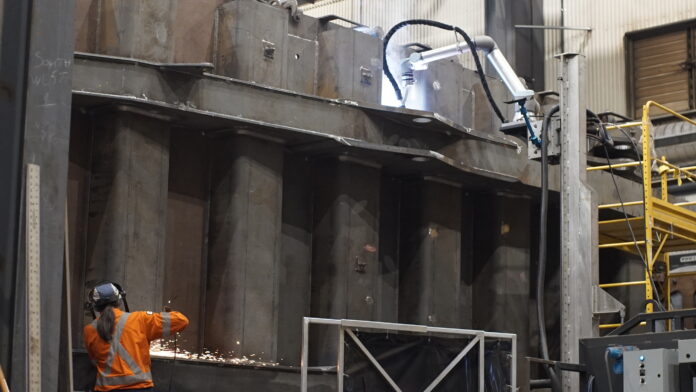
Carriere Industrial Supply (CIS) in Sudbury, Canada, produces heavy equipment for harsh mining environments; much of it—such as hauling equipment, scoops and earth movers—is used to move material from underground to the surface. Like most manufacturers, the company is adapting to a changing workforce—hiring new workers and retaining skilled talent, while strengthening its safety culture so that every employee goes home safely every day.
Automation is an ideal approach for repeatable applications. But in a low-volume, high-mix manufacturing environment, and with many large workpieces that are difficult to move, traditional robots may not be considered.
The CIS team discovered Universal Robots (UR) at a trade show and was immediately struck by the sight of collaborative robots (cobots) performing tasks while people interacted with them. Cobots from UR allow CIS to bring the robot to the work—rather than the other way around—and their easy programming empowers workers to continuously innovate to improve quality and output.
Plasma-cutting cobot empowers employees while saving 1,000 hours on a single project
The first project CIS identified for the UR application was plasma cutting of large metal parts. Manual cuts required extensive cleanup due to the accumulation of dross at the bottom of the piece along with the jagged edges that occur when workers need to reposition themselves for long cuts. Reducing the cleanup time was an ideal area for improvement. Pierre Levesque, manager of innovation and technologies, says, “Using a robotic arm, we knew that we would get a more precise cut and the possibility of eliminating all of the grinding and cleanup of the joints.”
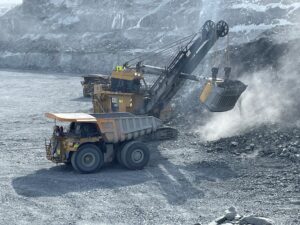
CIS chose the UR10e, which met both its reach and payload requirements, even with the weight of the plasma cutting tool and long workpieces. And despite the size and power of the robot arm, Levesque describes it as a “very approachable robotic cell” in terms of ease of use, even for operators with no robotics experience. They can place the workpiece on the table, “teach” the robot where the part is, and run the program for a clean, precise plasma cut, even on curved parts with complex geometries.
After some innovative programming, the cell became even more approachable for operators, who were excited to make continual adjustments to improve quality and output. (See Sidebar for details on programming the plasma cutting application.) Mason Fraser, junior software engineer at CIS, initially programmed the cutting of the most complex parts from start to finish, then built a new URCap program (software handshake between the cobot arm and its peripherals accessible on the cobot’s teach pendant) that “puts the operator in the driver’s seat” with an easy-to-use interface. Now the operators are fully engaged in instructing the robot on the points and speed to do the cut.
Levesque adds, “What the URCAP does is augment that operator’s ability by automatically navigating any plate geometry imperfections, and adjusting corner speed when necessary, based on the geometry and the points they provided. What you end up with at the end is the operator feeling in control, but elevating the game to make sure that the right parameters, the speeds, the material you are cutting—all that’s covered through the URCAP. So now you have a very successful cut, reduced time, reduced risk for the operator, and it is a win-win for both the operation and the operator.”
While operators appreciate that the work is more rewarding and less physically demanding, CIS also saw significant time and cost savings. Previously, 80 percent of the plasma-cutting time was spent cleaning up the manual cut. On a single large truck body contract over the next three years, Levesque determined that the trimming process on that project alone would be more than 50 hours for every truck. Moving to a robotic application reduced that time to 12 hours per truck, ultimately delivering 1,000 hours and a significant cost savings on this project, exceeding CIS’ expectations
Levesque further adds, “The interesting thing is to see the operators taking it even further, and applying thought on their cut process. With the ease of being able to manipulate the robot and using the free drive to position the torch in different angles, the operators were taking more care on applying bevels onto the final parts, which was quite impressive.”
Marc Sauve, process leader for steel processing at CIS who runs the plasma cutting-robot, addresses the concern that some may have about robots and jobs. “If I had a colleague who was fearful of a UR robot coming to take their job, I would put them at ease,” he says. “Every one of those robots needs an operator, so it’s just an asset to them; it’s not a tool to remove them.”
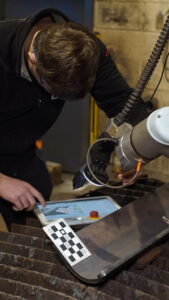
The versatility and mobility of UR cobots inspire innovation to double MIG-welding output and improve ergonomics
After the success of the plasma-cutting robot, CIS knew it could leverage that programming to MIG welding projects, even though that is a more difficult application. Fraser says, “The MIG-welding UR10e is doing similar profiles to what the plasma-cutting robot is doing, in the sense that it is following curvatures and following profiles; It’s just welding them instead of cutting them.”
Levesque knew MIG welding would pay dividends based on the large volume of welding work the company does. The challenge was to find repeatable parts in its low-volume, high-mix environment. One application stood out: the production of truck bodies with seven large side-by-side fillet-welded ribs, spaced three to four feet apart. Levesque says, “We envisioned that the welder can be working on one of the ribs while the cobot can be doing the next rib in coordination, and then you just index them over.” Fraser adds, “There’s a ton of welding on those, so we are trying to make this save time for the welders. They can work alongside the robot and split the work in half.”
Because of the length of the welds, the manual work raises critical ergonomic challenges to consider for welders. Fraser says, “The robot doesn’t care about ergonomics, so the operator can set up the robot and go work on other stuff that’s more productive and easier to do. Some of the more productive work they could do is cleaning up the welds, making them look nice. The more we can free them up to do that kind of work, the better.”
The MIG welding process is applied to massive parts weighing over 15 tons on the bodies of heavy-duty mining trucks; workpieces that can’t be fixtured inside a traditional robot cell. That required CIS to bring the robot to the workpiece, rather than the other way around. Unable to find a standard solution, the CIS team developed a custom welding skid that can be moved with a forklift to wherever the welding robot is needed. The robot is mounted on a lift to create a seventh axis to reach the entire weld on the side of a truck body. The relatively light weight of the UR cobot arm allowed CIS to develop this innovative approach.
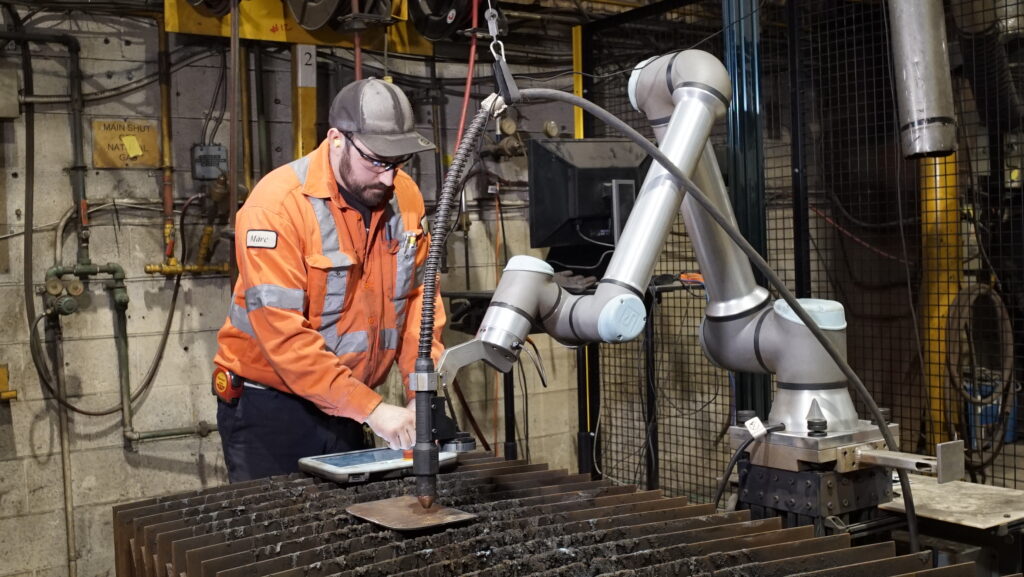
Ease of programming, extensive UR resources, and UR+ products contribute to success
“Traditionally, in industrial robot applications, you have to do all your programming in the cell with it, at a very reduced speed, and then leave the cell and press the button, and hope for the best,” says Fraser. In contrast, the open platform and ease of programming of the UR cobots was a significant advantage. While industrial robots typically use proprietary code that requires special software for development and test, Fraser says. “Universal Robots was a big, refreshing change from this because all the scripting and programmability in it was open, and it can interface with any software, any program, and any simulation tool. You’re not limited,” he explains.
As Fraser started the project, he was able to easily find the resources he needed on the UR website. “There was the UR Academy, which has great examples and tutorials on programming the robot. It actually gives you a full simulation of how a program would look and how to write it, without having to download any software. It’s all purely online, so that was extremely helpful.” Fraser and his team developed their own URCAP in-house, and says, “A lot of the tools available to us online, such as the UR+ Developer Forum, had a ton of resources and answers that I needed to get through the project. All in all, it ended up being a pretty great experience.”
Fraser also discovered the value of UR and its partner’s simulation tools to save time and effort. The Universal Robot’s UR Sim is an offline simulator for the Universal Robot pendant. It let him test the URCAPs he developed without having to upload them to the robot and test them on the production floor. Fraser explains, “The big benefit of being able to upload to a simulator rather than the actual robot was a major reduction in cycle times. We didn’t have to go back and forth to the robot to test it; I could test everything right on my computer.” He also discovered the UR-certified RoboDK offline simulation software on the UR+ website. RoboDK is an offline simulation tool where Fraser could load 3D parts data and program an entire path. “Because of the open nature of Universal Robots, uploading and reading UR script into RoboDK was a piece of cake, and it made testing very quick,” says Fraser.
Future projects with UR cobots
Now that CIS has experience with UR, they have confidence for future initiatives and application, such as machine tending in manufacturing assembly. Fraser is also considering adding vision capabilities to the MIG welding robots similar to the approach used for plasma cutting. Another option is implementing more complex cuts with the plasma-cutting robots such as coping for steel beams, or standard part cuts the robot could do quickly while minimizing disruption to production.
Levesque says, “UR is definitely a platform we’re going to continue to work with. The ease of use and the approachability of the platform is definitely appealing for the company.”
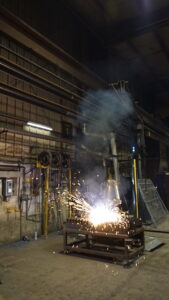 Automating Intricate Geometries for Plasma Cutting
Automating Intricate Geometries for Plasma Cutting
The CIS plasma-cutting application is set up with the robot in a typical position in front of a plasma-cutting table. Operators can present the workpiece and “teach” the robot where the part is positioned relative to it, and run the plasma cut. CIS started with a standard user-frame teaching mode of three points, which worked well for many parts, but any adjustments were difficult to do quickly. Fraser and his team found a Java computer-vision library called BoofCV and leveraged that with the jMonkeyEngine 3D game-engine library. With these tools and a webcam, they were able to project and line up the part in space, similar to augmented reality, to allow the operator to know exactly where to cut every time.
Once they started cutting, the team realized that none of the parts were formed perfectly off the brake press, so they needed to develop a way to maintain a consistent cutting height above the plate. Because the UR10e has a built-in force/torque controller, they used a drag nozzle on the plasma-cutting torch to drag along the surface of the plate to maintain a consistent distance while cutting. Unfortunately, the pressure generated from the torch nozzle caused it to bounce off the plate. To solve the issue, the team wrote a custom proportional–integral–derivative (PID) controller in pure UR script code, and used that to compensate for the torch height with voltage feedback. This allowed the robot to keep a steady distance off the plate for every cut.
Because the team had more than 20 years of experience with CNC machines, they knew about curve compensations and knew they needed to develop something that would follow the plate properly and would adjust for cornering. Levesque explains, “If you think about driving a car, you can’t take a corner at 90 km an hour, and the robot is no different. When you have complex geometries, we had to build some algorithms that would slow down around a corner.” The team applied that logic in a way that lets the cutting application augment the worker’s ability. “The person is in control,” Levesque says. “They give us the pathway and then we apply all those enhancements.” That allows someone with less experience to still have good-quality cuts, and guaranteed performance.



















